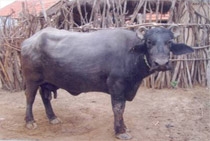
Origin & Breeding Tract:
-----------------------
Banni Buffalo breed was recognized as 11th buffalo breed of India by Breed Registration Committee, ICAR, New Delhi.The breed is originated from the Banni area of kachchh, which is a part of Kachchh district of Gujarat. It is located about 690 24’ E 230 42’N axis. Purebred animals prevalent in Bhuj, Nakhatrana, Anjar, Bhaahau, Lakhpat, Rapar and Khavda talukas, are heavily size with typical double and vertical coiling of the horn.The total area of Banni grassland is about 3847 sq. km. The inherently saline soil, deposited by long lost river systems, is naturally suited for nutritious grasses. There are more than 20 species of grasses and 20 species of shrubs found in the Banni pasture land. The rain water harvesting system in the region is known as “Khuira” , which is unique system of harvesting and conservation of water in the region.
The “sui-genesis” germplasm of kachchh i.e. “Banni buffaloes” are maintained by maldharis under typically and locally adapted extensive production system in its breeding tract. The breed is very hardy, well adapted to harsh climatic conditions. The performance recorded under field conditions shows the potentiality of the animals, which is regular in breeding and have high milk production potential. Banni buffalo known for high productivity, hardiness, reared under extensive production system, thrives on grasses available in the Banni grass land through night grazing and only source of livelihood for landless maldharis.In Banni, Maldharis adopted animal husbandry exclusive livelihood approach, they have been invented locally adapted extensive production system to reduce the cost of production. Banni buffaloes are trained to typical grazing on banni grass land during night and come to the villages in the morning for giving milk. This traditional system of buffalo rearing has been adapted to avoid the heat stress and high temperature of the day.
Physical Characteristics:
------------------------
Body colour - The body coat colour is black (90.09%) and copper (9.90%), whereas muzzle and eyelids are either black or brown
Horns - Horns orientation is vertical, inverted double coiling in 31.20% and vertical, inverted single coiling in 68.80% animals.
Eye - Eyes are prominent black and bright.
Tail - Medium in size
Body - Medium to large, compact and generally covered with hairs. Dewlap is absent and naval flap is medium.
Head - Wide with slight depression in the middle and no slope towards base of the horns.
Neck - Medium and thin without skin folds over the region.
Ear - Ear orientation is horizontal in majority of animals and length of ear is 29.30+-0.08cm.
Udder - Well developed, round in shape and squarely placed. The hind and fore quarters are uniformly well developed, whereas typically whole udder looks like four equal divisions with teats well attached to each quarter.
Teats - Animals have conical teats with round and pointed tips.
Production Traits
The production performance of Banni buffalo was evaluated under In-Situ Conservation Project implemented during 11th five year plan by S.D. Agricultural University, Sardarkrushinagar with the participation of maldharis in Banni area of Kachchh.
Average production performance of Banni buffalo under field conditions
• Average lactation length (days) - 300.96 + 4.43
• Average lactation milk yield (kg) - 2857.21 + 89.76
• Average daily milk yield (kg) - 11.53 + 0.07
• Average Fat% - 6.65 + 0.11

